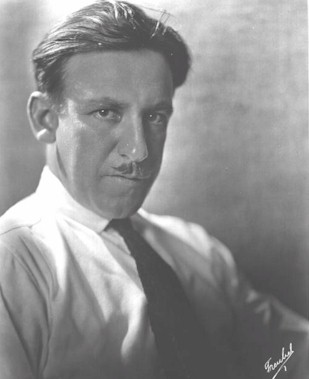Tod Browning (Tod Browning)

Motion-Picture Director and Screenwriter. Known as “The Master of the Macabre”, he was one of the most idiosyncratic artists ever to work in Hollywood. Browning was born in Louisville, Kentucky. At 16 he ran away from home to join a travelling circus, earning his keep as a contortionist and clown. It was the formative experience of his life and determined the kind of filmaker he would become. Several of his films would have sideshow or theatrical settings, and themes of role playing and illusion would recur in nearly all his mature work. Browning drifted into films as an actor around 1915. He was one of D. W. Griffith’s assistants on “Intolerance” (1916), and in the Modern Episode of that film he drove the sports car that sped Mae Marsh to her “last-minute rescue” of Bobby Harron from the gallows. Browning’s reckless driving nearly ended his career just as it was beginning. In June of 1915 he was critically injured in a car crash that killed his passenger, actor Elmer Booth. Hospitalized for weeks, he managed to write several scripts, including the notorious Sherlock Holmes spoof “The Mystery of the Leaping Fish” (1916). The film starred Douglas Fairbanks as “Coke Ennyday”, a strung-out detective who can barely stay away from the needle long enough to solve a crime. The story made light of the substance-abuse issue that became no joking matter for Browning. Lingering pain and suppressed guilt from the accident led to a drinking problem that took him years to overcome. Meanwhile, Browning’s success as a screenwriter brought him directing assignments. His early features, beginning in 1917, where mostly routine melodramas and action flicks, but one, “Outside the Law” (1921), was a portent of things to come: it was his first to star “The Man of a Thousand Faces”, Lon Chaney. The two became friends and hoped to work together again. Their chance came in 1925 when Browning joined MGM, where Chaney was under contract. They promptly scored a box-office smash with “The Unholy Three” (1925), a weird tale about the criminal exploits of a trio of crooks: a ventriloquist posing as an old woman (Chaney), a cretinous strongman, and a scheming dwarf. There was also a comely pickpocket (Mae Busch) for “romantic interest”, and a very annoyed gorilla who brings about the denouement. It marked the beginning of Browning’s great series of morbid melodramas: “The Black Bird” (1926), “The Road to Mandalay” (1926), “The Show” (1927), “The Unknown” (1927), “London After Midnight” (1927), “West of Zanzibar” (1928), and “Where East is East” (1929). Browning wrote original stories and collaborated on the scripts for many of these. After 1927 he also functioned as his own producer, giving him an autonomy enjoyed by few directors within the studio system of the period. Browning’s films were popular with audiences, but it was a long time before he got his due from critics and historians. No doubt they were put off by the “unrespectable” genre of melodrama he favored, by his artless visual style and plebian taste. In his own time he was accused of being crass, exploitative, even downright sick. But one should not be misled by the aesthetic shortcomings of Browning’s films. With their bizarre plots and grotesque characters, brooding atmosphere, and emphasis on physical and spiritual deformity, they reveal a profound obsession with the dark side of human nature. No one helped Browning realize his twisted visions better than Chaney, who starred in nine of his films and gave him performances of stunning depth and complexity, often in contrasting dual roles. Truly kindred spirits, theirs was one of the great collaborations of American Cinema. Chaney’s death in 1930 ended this partnership, but Browning went on to have his biggest hit with “Dracula” (1931). His only venture into Gothic horror, it remains his best-known, if not his best, film. It’s success encouraged MGM to give Browning carte blanche on his next project. “Give us something to out-horror ‘Frankenstein'”, he was told. The result, “Freaks” (1932), did that all too well. A ghastly goulash of lust, greed, and vengeance set in a travelling European sideshow, it subverts our atavistic fears of the abnormal by offering as its heroes a real-life assortment of midgets, dwarfs, armless and legless beings, pinheads, mongoloids, bearded ladies and Siamese twins, all presented with sympathy and compassion. By contrast, the villains are a pair of acrobats, depraved creatures beneath their perfect physiques. Even Browning’s supporters couldn’t handle this one. After a San Diego preview that sent one woman screaming from the theatre, “Freaks” was drastically cut and then shelved after a limited release. It was banned in England for 30 years and did not appear on American television until the late 1960s. After the “Freaks” fiasco, MGM put Browning on a tight creative leash. He made four more films before his retirement in 1939; only “The Devil Doll” (1936) has the flavor of his earlier work, but it is marred by a compromised script and weak ending. By 1942 Browning was so out of the Hollywood loop that the trade paper Variety mistakenly published his obituary. He lived for 20 years more, in relative seclusion at his Santa Monica home.
Born
- July, 12, 1880
- USA
- Louisville, Kentucky
Died
- October, 06, 1962
Cemetery
- Angelus Rosedale Cemetery
- Los Angeles County, California
- USA

